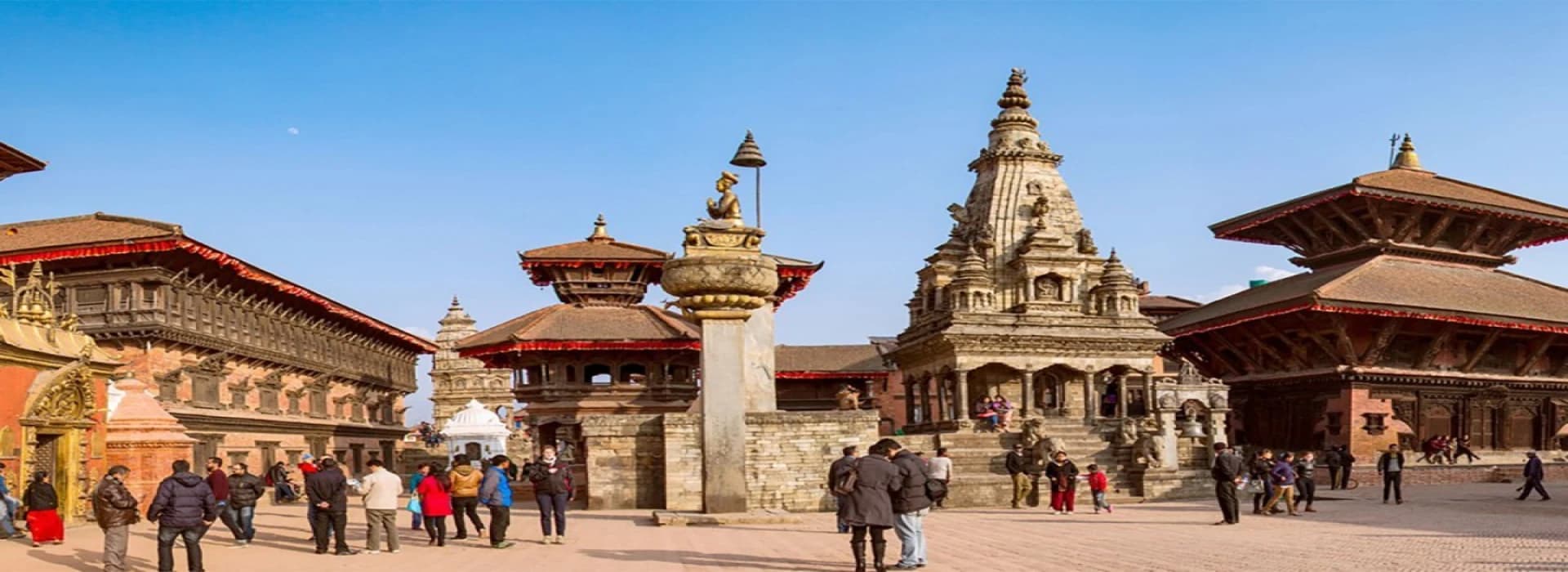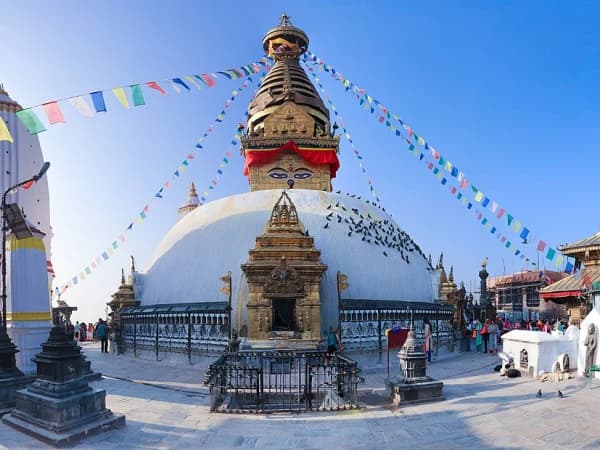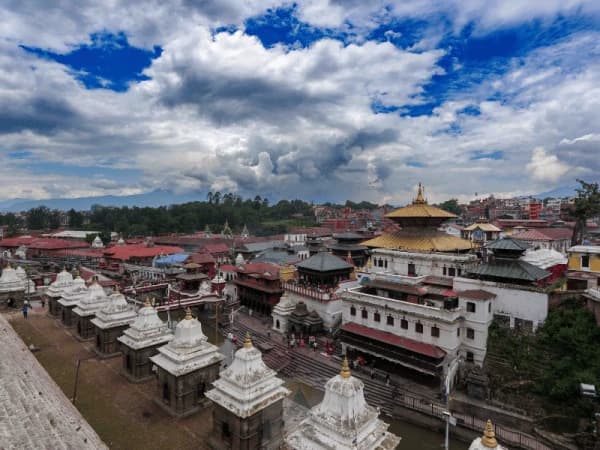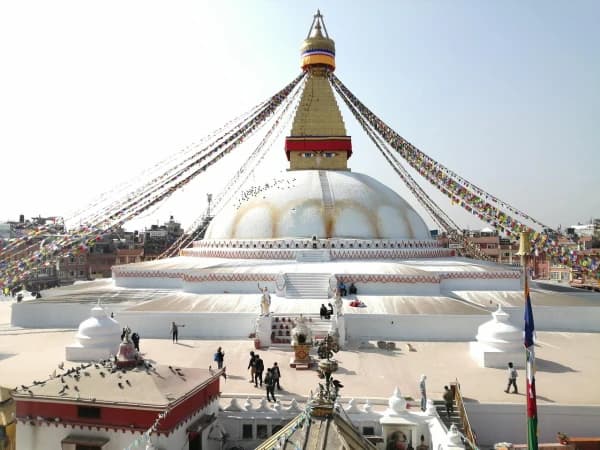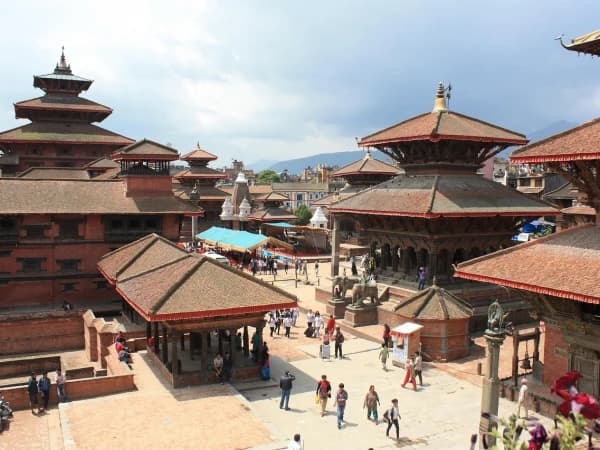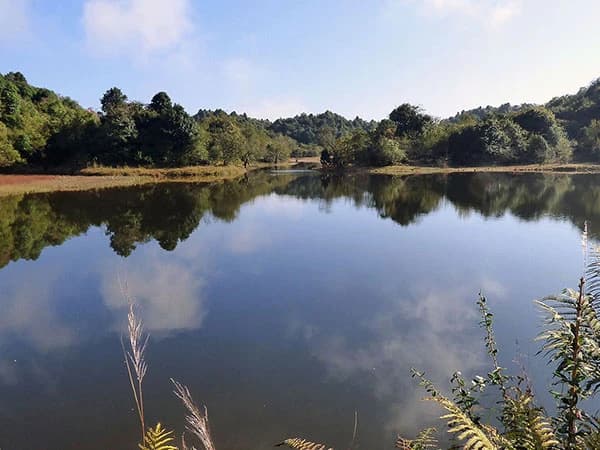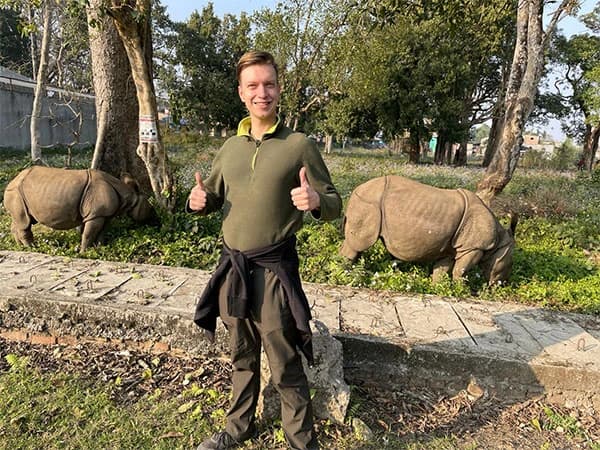The Kathmandu UNESCO Day Tour by Ammonite Adventure was beyond awesome. Our guide Raj explained to us in detail the
Are you looking for a one-day tour around Kathmandu? A day trip to UNESCO World Heritage Sites in Kathmandu can allow for that, having a full day visiting the product of centuries of architectural and artistic efforts, and sites featuring ritual performances and sites still living traditions.
Whether you are at the end of your travels and have a couple of hours available (you could fit this into about four hours) or you are starting your trip and want to get to know Nepalese culture and history before your trek/adventure (you could do this as one of the very first things for your trip) this is a wonderful experience to choose.
This experience features historical and cultural places at some of the most recognised heritage sites in Kathmandu, which include: Kathmandu Durbar Square (Basantapur Durbar Square), Swayambhunath (the monkey temple), Pashupatinath Temple, Bouddhanath, and others!
Taking a walking tour around Kathmandu Durbar Square, visitors will discover palaces and intricately-carved temples and royal courtyards, as well as visiting a one-of-a-kind home to the Living Goddess. Each of these sites offers a glimpse into Nepal's royal heritage and wonderful craftsmanship, and the fine art heritage of the medieval period.
On top of a hill, Swayambhunath gives an inimitable view of the valley and a spiritual vibe due to the combined presentation of Hindu and Buddhist.
Pashupatinath ranks as one of the most sacred places of Hinduism. The area is full of life and death-related rituals that take place along the flowing Bagmati River.
After that, your eyes will follow the incredibly large dome and the bright moving prayer flags of the Boudhanath Stupa, a place that is devoted to meditation and calmness among monks, pilgrims and prayers.
This is the tour for you if you've finished your main trekking itinerary and would like to enjoy more culture, or perhaps, your schedule permits you a taste of Kathmandu culture before moving on. Art lovers, cultural enthusiasts, photographers, spiritual seekers, or anyone else with an interest in Nepali heritage will enjoy this great day trip.
At Ammonite Adventure, we provide for this trip both privately and as a group-joining adventure. Visiting all 7 UNESCO sites in one day is not possible; thus, a complete tour of the 7 UNESCO sites will require at least 2 days. Our 1-day UNESCO trip will visit 4 UNESCO sites.
Main Highlights
- Visit four different UNESCO World Heritage sites in Kathmandu.
- Learn about the culture, religion, and history of Kathmandu with an expert local guide. Explore the sacred architecture of the Swayambhunath Stupa (Monkey Temple) from above and what it represents.
- Head to Pashupatinath Temple, a sacred place, among the most significant Hindu shrines devoted to Lord Shiva.
- Also, admire the massive Bouddhanath Stupa, which is one of the largest Buddhist stupas in the world and take part in a local prayer ritual called ‘kora’ by the devotees.
- Moreover, take a walking tour of the ancient Kathmandu Durbar Square (Basantapur) and see the temples, palaces, and courtyards, which tell the story of the city’s royal past, centuries old.
- Furthermore, explore the Newar culture, which is the valley’s heritage and is vividly reflected in the art, architecture, and lifestyle of the people.
- Experience a short day tour, but with a heavy spiritual and cultural focus, which offers a glimpse of the deep soul of Kathmandu and its spirituality.
Private and Fully Guided Day Tour to 4 UNESCO Heritage Sites
This exclusive, Private, and Fully Guided Day Tour to four UNESCO World Heritage Sites provides a uniquely intimate and personalised experience of exploration. With this tour being completely private, you will have an expert guide with you for the entire day, whose sole focus is your private exploration. They will customize the day to suit your interests in the world heritage sites, which means the day is truly dedicated to what you would like to focus on. You'll be able to ask questions freely, explore at a leisurely pace, and have flexibility with your time, so you can absorb all of the historical, unique and cultural aspects of each site.
Through your guide offering in-depth detail and anecdotes about each site, the deeper essence of the heritage is illuminated, whether it be with factual information from architectural history, or contextual information from stories, myths or legends surrounding each site.
Your private tour will provide seamless transportation between each site, as well as an arranged personalised experience for your day, focused on your comprehension and enjoyment of each UNESCO World Heritage Site you will engage with.
How Many World Heritage Sites are in Nepal?
Nepal has 10 UNESCO World Heritage Sites. These sites are recognised as outstanding both from the cultural and natural perspectives. There are 8 cultural sites and 2 of natural kinds.
Cultural World Heritage Sites
The Kathmandu Valley is the home to seven monument zones: Kathmandu Durbar Square, Patan Durbar Square, Bhaktapur Durbar Square, Swayambhunath Stupa, Pashupatinath Temple, Boudhanath Stupa, and Changu Narayan Temple. These places represent Nepal's past, art, and architecture.
Lumbini, the birthplace of Lord Buddha, is a major pilgrimage site. It has ancient temples and monuments.
Natural World Heritage Sites
Sagarmatha National Park is known for Mount Everest and its various ecosystems. Chitwan National Park is the place where very rare animals like the Bengal tiger and one-horned rhinoceros are kept safe.
During our One Day UNESCO guided Tour, you will have a chance to visit 4 UNESCO World Heritage Sites, which include Kathmandu Durbar Square, Swayambhunath Stupa, Pashupatinath Temple, and Boudhanath Stupa. This guidance package is an excellent way of immersing yourself in Nepal's cultural heritage.
UNESCO Sites You Will Visit On This Day Trip With Their Entry Fee 2026/2027
Kathmandu Durbar Square (Basantapur Durbar Square)
Place: Kathmandu Valley Centre
Kathmandu Durbar Square (Hanuman Dhoka Durbar Square) is a royal palace complex in which the Malla Kings and later the Shah Kings ruled and is a UNESCO World Heritage Site because of its beautiful Newar architecture, wooden windows with carvings, temples and courtyards.
Things to do
- Hanuman Dhoka Palace Complex: It housed the king and is extremely elaborate in both architecture and historical artefacts.
- Kumari Ghar (House of the Living Goddess): Home of the living goddess, a small girl, worshipped to be the living goddess Durga.
- Kasthamandap: A wooden building, built from a single tree, for which the city is named.
- Gaddi Baithak: White marble building for royal functions and meetings.
- Shiva-Parvati Temple: A temple of Hindu gods, Shiva and Parvati, spectacular front.
- Kal Bhairav Statue: A huge stone statue of Kal Bhairav, purportedly a god of strength and protection.
Entry Fees (2026):
- Foreign Nationals: NPR 1,000
- SAARC Nationals: NPR 500
- Nepali Citizens: Free
Important: Children under 10 enter for free.
Swayambhunath Stupa (also referred to as The Monkey Temple)
Location: The west side of the Kathmandu Valley
The Swayambhunath Stupa, or Monkey Temple as it has become known due to the local monkeys, is much more than a famous historic site of Nepal; it is actually an ancient religious monument built atop a hill. Within the stupa, there are many sacred religious sites that are seen as points of peace between Buddhism and Hinduism. The property was declared a World Heritage Site by UNESCO in 1979.
Main attractions:
- The Stupa: This mound-shaped structure, with its all-seeing eyes of the Buddha symbolism, represents compassion and wisdom.
- The Vajra Throne: A holy elevated platform, which is symbolic of the seat of Buddha.
- Monasteries and Shrines: Some sprinkled around the hill give you insight into the life of a practising Buddhist monk.
- The View: From the top of the hill, you are sure to be taken aback by the view of the Kathmandu Valley.
Entrance fees (2026)
- Foreign Nationals: NPR 200
- SAARC Nationals: NPR 50
- Nepal Citizens: Free
Important: Children under 10 enter for free.
Pashupatinath Temple
The location of the Temple is on the banks of the Bagmati River, Kathmandu.
Dedicated to Lord Shiva, Pashupatinath Temple, located on the banks of the holy Bagmati River, is the most sacred of all Hindu temples. This site is designated as a UNESCO World Heritage Site and is an important pilgrimage destination, with nearly one million visitors at the time of the Maha Shivaratri festival.
Highlights:
- The Main Temple: pagoda pagoda-style temple that enshrines the holy Shiva linga, but only Hindus may enter.
- Arya Ghat: A burning ground at the riverbank providing a very insightful view of Hindu rites of death and funerals.
- Bashantapur Temple: The temple complex features the temple of the goddess Bashantapur.
- Abundant Temples and Shrines: There are over 500 temples and monuments dotting the area, each being different from the other in terms of unique significance.
Entry Fees (2026):
- Foreign Nationals: NPR 1,000 per day per entry
- SAARC Nationals: NPR 1,000 per day per entry
- Local Nepalese: No Charge
Remark: What is more, Indian people can enter for free.
Bouddhanath Stupa
Boudha is the major stupa holding location for the northeastern part of the Kathmandu valley.
Boudhanath Stupa, located in the northeastern part of Kathmandu, is the second biggest and one of the most important Buddhist Stupas in Nepal. This World Heritage Site is the core of Tibetan Buddhism and, therefore, it is a destination of pilgrimage for the followers of this religion all over the world.
Key Highlights:
- The Stupa: One of the largest mandala-shaped buildings with Buddha's eyes painted on the sides, which represent the unity of all living beings.
- Monasteries: Around the stupa are numerous Tibetan monasteries that help you to understand the life of a monk.
- Prayer Wheels and Flags: Prayer to God, if you want to spin the prayer wheels while walking around the prayer wheel and also at the same time see the colorful prayer flags hanging and walking around you.
- Tibetan Culture: The area is full of Tibetan culture, and the shops are selling traditional crafts, thangka paintings, and Buddhist artefacts.
Entry Fees (2026):
- Foreign Nationals: NPR 400
- SAARC Nationals: NPR 100
- Local Nepalese: Free-of-Charge
Note: Absolutely free entrance is opened to children below the age of 10 years.
Kathmandu UNESCO Day Tour: A Perfect One-Day Itinerary
Wondering what to do in Kathmandu for just one day? If so, our UNESCO Day Tour is a perfect way to introduce you to the rich cultural landscape of Kathmandu. It is ideal for travellers short on time to experience the extensive history and architecture built on spirituality in Kathmandu.
You can easily add this tour at the start or finish of your trekking in Nepal, making it an efficient add-on to your Nepal itinerary as you explore the area and don't have a lot of time to explore each destination.
Whether you are acclimatising in Kathmandu or ending your adventure in the capital, this day tour offers a good blend of history, culture and spirituality. So, join us on a journey through the Kathmandu UNESCO World Heritage Sites and get to the heart of Nepal's cultural tradition.
Fast and short time arrangement for Kathmandu 1 Day UNESCO Tour
The Kathmandu 1 Day UNESCO Tour is perfectly suited to all travellers who are short of time, short-term arrangement, and you can even make a last-minute booking. Or we can quickly and easily turn everything fully for you to set it up last minute.
Since this tour visits the major UNESCO World Heritage Sites within the city, it does not require extensive planning or long preparation time.
Our team has extensive experience with last-minute bookings, and a private guided, fully planned tour itinerary can be quickly accommodated based on your schedule.
The flexibility found in this tour makes it an ideal choice for a 1-day UNESCO tour in Kathmandu, helping to maximise your limited time and allowing you to explore historic and cultural sites. If you find yourself with unexpected free time or find yourself with a change of plans, this tour will provide you with an informative, enjoyable experience, all on short notice, just for you.
1 Day World Heritage Sites Tour in KTM Cost 2026 and 2027
The Day Tour to UNESCO Heritage Sites in Kathmandu is an inexpensive and flexible tour package, starting from only $80 per person. Pricing is dependent on the size of the group, and the cost gets cheaper as more individuals join the tour. The costs for 1-2 persons are $120, for 4-7 persons are $100, and for 8 - 15 persons, the cost starts at $80 per person.
The price includes a private guide and transportation, which facilitates a better and more cultural experience. The entrance fees for the heritage sites would be separate from the package price. Overall, this day trip with group pricing and cultural experience is ideal for families, friends or small groups in terms of any type of cultural visit being very accessible.
Pricing Structure:
- 1–2 Persons: US$ 120 per person
- 3–7 Persons: US$ 100 per person
- 8–15 Persons: US$ 80 per person

